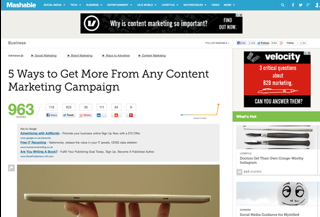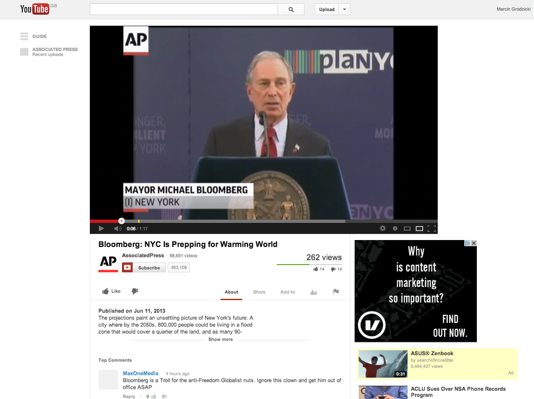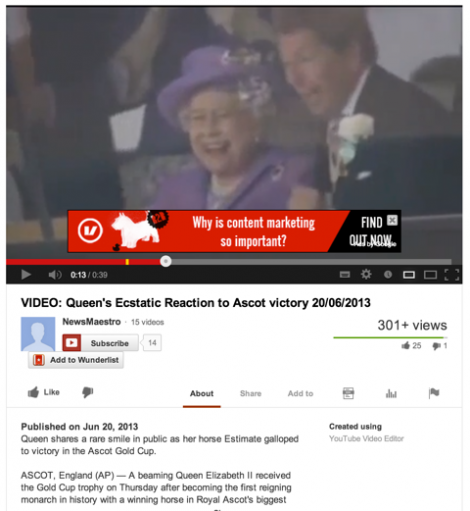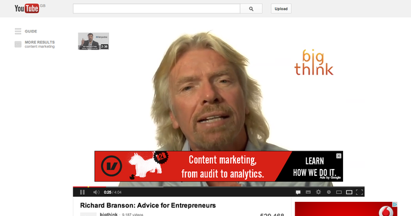As we whinged about in our Crap slideshare, it’s getting harder and harder to get content discovered and downloaded. That means content marketers will have to get better and better at the kinds of things we thought we’d left behind: like dreaded outbound, interruption-based advertising (gasp!).
That actually doesn’t bother me: if we do it intelligently, advertising that offers content will out-perform product-based advertising and will still be serving the prospect, in the spirit of content marketing and inbound and all things holy.
So when Marcin Grodzicki set up a call to discuss a new content retargeting platform his team was building (now called Resonance), I was happy to take the call. And by the end of the call, I was eager to give his new platform a try.
Definition break: “Retargeting marks or tags online users who visit a certain brand website with a pixel or a cookie and then serves banner ads only to the people who have shown at least some amount of engagement in the original brand.”
I know, I know: if advertising is a dirty word these days then, to many people, ad retargeting is like animal porn: unthinkably yukky.
I’m a card-carrying hater of crass retargeting (as posted here, “When retargeting turns into stalking’). But I actually believe that retargeting (or remarketing if you prefer) is a powerful technique that can really improve some of the metrics content marketers care most about (like traffic, engagement and shares). As long as it’s done intelligently.
Why I think B2B remarketing has a role to play in content marketing
- Because something like 90% of your web visitors will never make themselves known to you – and may never come back.
- Because people who make it to your website even once are worth the effort – they’ve already responded to something you’ve done. That makes them much more likely to be prospects than people who haven’t.
- Because the data speaks for itself – our friends at Mediaplex tell us that, in B2C, the numbers are pretty indisputable: done right, retargeting can dramatically out-perform normal advertising.
So combining retargeting with content marketing – chasing folks who have visited your site with content offers – should be a pretty powerful combination.
The downsides of B2B content retargeting
- It can be creepy. It’s weird to have a pair of shoes I looked at on a brand’s website follow me around the web for days or even weeks.
- You have to pay for it. So it’s competing with every other way to buy eyeballs and fingertips.
- You risk preaching to the converted – some of the people you retarget have already bought (or read your content). So it can look like you’re wasting money chasing them (even if you are only paying for clicks, not impressions). For some brands (like awesome B2B content marketing agencies) this perception itself can be damaging. It makes you look like an amateur.
So what I want to find out is this: how big is the upside of content retargeting? How big is the downside? And are there ways that content marketers can harvest the upside while minimising the downside?
The Resonance approach
Resonance’s big idea is that content marketers have ‘content funnels’ – and that a prime goal should be to get people to consume as much of our content a possible, moving down the funnel as they go. So if we can get more people to consume all of the core content pieces in our funnel, we’ll be turning more casual visitors into prospects.
With normal retargeting, you capture all users of the site and retarget them with one or many ad units. The trouble is, you have little control over who sees what so people will be exposed to the same content constantly and will soon develop banner blindness (or get really annoyed).
So the content funnel approach is a very cool spin on standard content retargeting: understand what content each person has already seen so you can offer them the next most relevant piece (instead of chasing everyone with the same ads). But does it work?
Let’s find out: the experiment.
We need to know the answers to the above questions before we can recommend this new kind of content remarketing to our clients. So we asked Marcin if he could run an experiment, using the Resonance platform to run a content remarketing program for our own content library. He agreed, so we put aside a micro-budget to run a test: looking at retargeting versus normal (un-retargeted) ad banners; and at content versus product ads. So people that have seen the Content Marketing Manifesto will be retargeted with ads for The Big Fat Content Marketing Strategy Checklist and so on, until they have seen (clicked through to) all of our content.
A caveat: our traffic numbers aren’t exactly Amazonian and our budget was even smaller, so it can be hard to get solid numbers. But we hope to at least get an indication as to whether or not content retargeting works.
Phase 1: Product Ad Retargeting
We created an ordinary retargeting campaign for two of our most important services: B2B Strategy and B2B Content Marketing. The campaign setup cookied our site visitors and put them on a retargeting list. Then we showed those people banners for our products across display advertising inventory all over the web (including sites like Wired, CNet, TheDrum, VentureBeat, Mashable or Youtube). With the help of the Resonance team, we tracked all of the key metrics of the campaign, like price of impressions or click-through rates. We also analysed how the traffic we generated performed on our site. (We’ll report back on this in a future post).
Now it’s time for the sinister Phase 2 of the experiment:
Phase 2: Content Ad Retargeting
In the second phase we’re taking people on the content journey – guiding them through our eBooks and Slideshares and making sure that each visitor gets the most relevant content exposure. Banner creative will be customised for each content piece and served in an ‘advertorial’ style. (We will also sample our users and see if we can select the ‘best performing’ group based on the way they interact with our content).
Our focus will be on improving all four metrics: Pages per visit, Time on site, Bounce rate and Conversion.
So far, the results are really interesting. But this phase has just started, so we’ll report back in the second post on this experiment.
A few bits on the ‘How’ part
We left the ads themselves to Resonance because we wanted to take creative out of the equation: they just cranked out some simple ad banners and then used multi-variate testing to discover the best-performing ad units.
We then placed two retargeting tags on the content pages selected – using Google Analytics to decide on the best candidates
And dropped some analytics code in the footer of our site – so we can track our returning visitors across every page
We couldn’t select what sites our ads appeared on – this will be possible but it isn’t yet. That means we popped up in some very odd places.
One worry is that popping up on sites that have no relevance to content marketing makes us look like bad marketers. In truth, it’s the visitor that dragged the ad behind them, we didn’t buy inventory on the irrelevant site. But it looks like we did and that feels weird. It also jumps off the page and sings, “Retargeting happening here!” in a way that doesn’t happen when the ad is served on a relevant site.
Creatively, we might have some fun with this, doing self-referential ads that say things like, “It’s us again!” — remember, our target prospects are marketers, so they’ll be in on the joke (most audiences won’t).
So these ads on Mashable:
Look a lot more natural than this ad on YouTube:
Or this one, that appears to use the Queen as a Velocity spokesperson:
Or this one, that uses Richard Branson to shill Velocity:
An unsolicited Skype conversation with a client who got cookied:
Client: BTW – your digital remarketing efforts are working nicely
Neil: It’s a test. Might recommend for the content hub… Where did you see it?
Client: I’ve had ad placements in some funky places over the last couple of days. There’s one in front of me on Accountancy Age.
Neil: Think it’s too much? Would be interested in your feedback.
Client: Not at the moment I don’t, at all
Neil: Cool. I’ll tell Doug, he’ll be chuffed. We’re thinking it could be good for clients overall
…

Enjoyed this article?
Take part in the discussion












Comments
Marcin Grodzicki July 3rd, 2013
Thank you for the post, Doug, and most of all, for your understanding and willingness to go on this journey. The results are already surprising even for us and we still have more up our sleeve. Let’s get this content into the minds of clients!
John Watton July 3rd, 2013
Doug,
Good & bad news.
The good:
1. I think retargeting has more of a place in B2B than B2C, as considered purchases are a long haul & any opportunity to reinforce a brand over multiple touchpoints is worthwhile.
2. I was actually part of your experiment and was retargeted by you & thought – hey that’s Velocity!
The bad:
1. I get really annoyed by B2B brands interjecting themselves into my consumer experience. With the best will in the world I really don’t want to sit through even 4 seconds of a middleware ad when my kids are showing me a minecraft tutorial on YouTube.
2. Sorry, but you fell into (1). The even worse thing is I’m already a customer.
So a couple of things need to change to stop the current platforms being a bit of a blunt instrument:
1. Ad networks need to provide more granularity in letting advertisers choose which sites their ads appear on.
2. Retargeting needs to develop a behavioural dimension, which lets advertisers serve up ads not only on whether a consumer has visited a site (and nurture them thru a funnel) but also on other data such as purchase history, CRM profile or other behaviour.
John
@jwatton
Doug Kessler July 3rd, 2013
Fantastic feedback, John — and I couldn’t agree more.
We’re looking at being able to select the sites the ads appear on.
And it’s important to be able to see what people have already seen and done so you’re not chasing the converted.
I do find it jarring when I see a B2B ad in a B2C context. But then, I don’t have to click on it if I’m not in the mood. What it does do is scream “Ad retargeting!” in a way that B2B context does not. That’s why I think some self-referential creative that admits it’s retargeting might be fun to try.
Marcin Grodzicki July 4th, 2013
Hello John,
thanks for your feedback. We’re already working on both challenges you outlined, and actually we’re doing it for our own good. Regarding the consumer interruption – we already noticed that the traffic generated on weekends has lower performance, and there is no better feedback loop than ‘does it work’. Regarding no 2 – we are currently perfecting filtering out people that already have high engagement like you – we’re not quite there yet, but it should get better over the next week or two. We’re early pioneers of conversational marketing in the ad space, very focused on providing a solution that will work in the very fragile B2B relationship world – when we succeed though, our partners will gain a great channel of communicating with their target group.
Tracey James July 11th, 2013
Doug, I agree with much of what John wrote. You said ‘it’s weird to have a pair of shoes I looked at on a brand’s website follow me around the web for days or even weeks.’ True, but it’s even weirder to have a pair of shoes following you around that you’ve already bought!
And yes, ‘you risk preaching to the converted. For some brands (like awesome B2B content marketing agencies) this perception itself can be damaging. It makes you look like an amateur.’ Dead right. We follow you on Twitter and go to your website at least once a week, so we are indeed converted. Moreover, we’re a marketing agency in Sydney, Australia, so we’re not exactly prospective customers for Velocity Partners.
I found myself baulking at the idea that ‘ít’s the visitor that dragged the ad behind them, we didn’t buy inventory on the irrelevant site. But it looks like we did.’ Doug, I didn’t ask the ads to follow me around yet some of them are stalking me constantly. Talk about Banner Bullying, as you call it in another piece.
What’s mostly happening here is that ‘re-marketing’ is annoying us and turning us against the outfits whose ads follow us around. In my view, this new advertising medium needs to become a lot more sophisticated if it is to do anything else.
Best
Tracey
Doug Kessler July 11th, 2013
Great points, Tracey.
I do think retargeting must get smart or it risks being rejected.
But some of my own antipathy to being retargeted may be down to its novelty.
I’m not sure why I should feel more intruded upon by an ad that reflects my past behaviour and not intruded upon by an ad that crop-sprays me without even thinking about who I am.
I do think there’s an aversion to being ‘over-targeted’ — as if someone is making an assumption about me that I may not be comfortable with. This will be true of all personalisation and behavioural marketing — and more and more is coming.
How we respond to it all may come down to where it falls on the clunkiness/sophistication spectrum. Being chased by shoes you already bought is just stupid.
Marcin Grodzicki July 11th, 2013
Hi Tracey,
thank your for your opinion. Very valid point there, starting with ‘Clients should be excluded’ – this needs to be done, period. We already have a way of doing that for product based companies or those that have a sign-in web component to their client interaction. Also, the unlikely clients – like yourself – should be excluded, as basically it makes no sense to preach to them. This is harder to do, but we already have some ways of doing it.
When display advertising was introduced to the online world, it was clunky, cheesy and ugly. And people complained. When Facebook first introduced ads (hello Beacon) they had to retract it very quickly due to the outrage of it’s users. However, it all got better up to a point where ads online are often an important feature (like AdWords) of the user experience. Not to mention that in the process, those ads built thousands of businesses and millions of jobs. This is what we’re doing in the re-marketing in the B2B space with Resonance. Or at least our, humble, small piece of it.
Ken Roberts July 14th, 2013
What consumers and business buyers really need is an update of the old “bingo cards” in magazines.
But modernized in the digital age as a centralized place they can easily turn on/off an interest . That way if I’m in the market for a car or studio lighting or a marketing agency–I can check the settings and see the ads. But keep my information anonymous unless I choose to engage. So the service can be trusted by consumers yet offer very targeted placements to advertisers. Eliminate all the guesswork. Call it TrustAd. Get it? I better trademark that!
Speaking of which … “Resonance” is the name of a behavioral targeting platform from Certona used in ecommerce recommendations & personalization. Not exactly the same, but could be some brand confusion coming!
Marcin Grodzicki July 16th, 2013
Thank you for the comment, Ken. What you described, to some extent is how the AdChoices (http://www.youradchoices.com/) works, and I’m sure it will get better over time, as the regulation will too.
Ray Coppinger July 25th, 2013
Thanks so much for sharing your content remarketing Doug, it is an oft-suggested tactic when dealing with agencies but I have never really seen a compelling case study for B2B marketers to invest their time and effort heavily in it. My gut feeling has always been that brands with great content should be able to leverage retargeting to intelligently offer their content and nurture interest in their brand so great to see you are putting some science and effort into it.
Just wanted to see if you had any updates on how the experiment has been going? Any further insights or learning’s?
Doug Kessler July 26th, 2013
Hi ray — thanks for the comment.
An update is imminent!
Interesting findings…